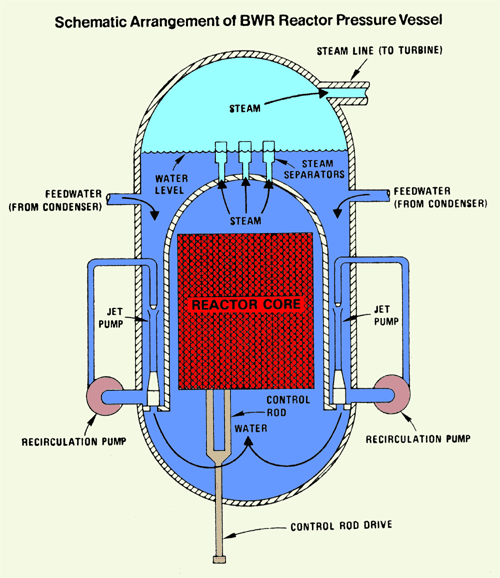
Nuclear Reactor:A Radioactive Waste-Making Machine.
A typical 1,000 megawatt reactor creates about 250 POUNDS A DAY of "spent fuel", aka, "barely-used reactor cores".
----------------------------------------------------------
A small amount of electricity is also produced. However, this relatively small benefit is offset by the cost of mining the radioactive ore, the cost of production of the nuclear fuel (milling, enrichment, and fuel fabrication), the cost of construction of the power plants, the cost of cancers, leukemias, and birth defects caused by numerous radiation releases during power plant operation and during each phase of the nuclear fuel cycle, the cost of storing and/or reprocessing the used reactor cores, the cost of transporting them between each stage, the cost of cleaning up and "decommissioning" the reactor, and the cost of catastrophic failure if the reactor cores are dispersed into the environment.
----------------------------------------------------------
Below are several schematic diagrams of a Boiling Water Reactor Pressure Vessel. This unit is about four stories tall:

The above image is from a Nuclear Mafia web site.

-- The above image is from: The Silent Bomb: A Guide to the Nuclear Energy Controversy, Edited by Peter Faulkner, page 85,Vintage Books, NY, July, 1977 (colorization by this author).
Below is a schematic drawing of a GE BWR:

-- The above image is from: The Silent Bomb: A Guide to the Nuclear Energy Controversy, Edited by Peter Faulkner, page 283,Vintage Books, NY, July, 1977 (colorization by this author).
The reactor cores remain radioactive for about a million years after their brief use in the reactor (two to six years). The waste must be carefully isolated from humans and other living things during this entire time. NO EXCEPTIONS.
----------------------------------------------------------
Below are schematic diagrams for PWR and BWR reactors, the two types used in the United States:

-- The above image is from: The Bridgeport (Connecticut) Telegram, April 30th, 1980, page 38 (colorization by this author).
Many ideas for how to safely store the waste have been suggested, but none have been successfully implemented, and none solve the problem of transportation accidents along the way to the final repository, whatever it might be.

-- The above image is from: Northeast Utilities (Connecticut Yankee) Information Brochure, June, 1973, pages 10-11 (adjusted for the Internet and additional colorization by this author).
----------------------------------------------------------

-- The above image and subtitle is from a magazine article about nuclear power, probably 1956. (Title colorized by this author; juxtaposition was apparently unintentional.)
----------------------------------------------------------
Here are the reactor designs shown in the article from the 1950's:




-- The above images are from a magazine article about nuclear power, probably 1956. (We have not been able to determine which magazine the images are from. Perhaps Life, Look, etc.. Any assistance in positively identifying this source will be appreciated!)
---------------------------------------------------------
Another definition for Nuclear Reactor is: Terrorist Target. This is often considered a new problem, that is, post 9-11. However, this lie is exposed when one simply considers the title of this 1980 book:
NUCLEAR POWER PLANTS AS WEAPONS FOR THE ENEMY: AN UNRECOGNIZED MILITARY PERIL, by Bennett Ramberg, University of California Press, Studies in International and Strategic Affairs, William Potter, Editor, Center for International and Strategic Affairs, University of California, Los Angeles, CA (“Introduction to the Paperback Edition” Copyright 1984 by the Regents of the University of California). D.C. Heath and Co., 1980, 1984.
See the cartoon from 1978 by Stephen Croall & Kaianders, under the definition for MEMORY, for additional proof that this problem was IGNORED, not OVERLOOKED, as the nuclear industry would have you believe.
----------------------------------------------------------
Copyright (c) 2002 by Russell D. Hoffman. All Rights Reserved